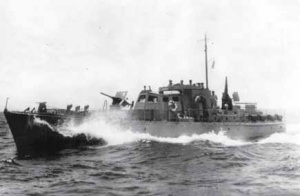HDML 1323 in its wartime configuration.
SDB 1323 was brought back into sea-going service in 1946 and in May that year was attached to the 20th Minesweeping Flotilla serving in New Britain and Solomon Islands waters between June and November. It then served in Australian waters until October 1947. On 6 November 1947 it arrived in Sydney from Queensland where it remained until it again paid off on 10 September 1948.
In 1950 SDB 1323 was transferred on loan to the Royal Navy for service in the Far East, based in Hong Kong.
The Pearl River incident
On 9 September 1953, ML 1323 was on patrol off the western side of Hong Kong in the Pearl River estuary was it was fired upon by a Chinese gunboat. During this action the vessel was subjected to a continuous barrage of shell and machine gun fire and its captain and half its crew were killed.
Remarkably, those who survived the engagement managed to effect temporary repairs and recover the stricken vessel to Tai O pier, on Lantau Island where the survivors received first aid. Further assistance was rendered by the British destroyer HMS Concord which had hurriedly sailed from Junk Bay, Hong Kong, in an attempt to intercept the aggressor.
Six Royal Navy personnel and one member of the Royal Hong Kong Defence Force were killed in this action.
ML1323 required extensive repairs but was eventually returned to service. As economic assistance for Southeast Asia Treaty Organisation (SEATO) defence, ML1323 and ships of the same class 1326, 1328 and 1329 were later presented as gifts to the Philippines Navy in 1958. On 13 August 1958 USS Oak Hill departed Hong Kong for Manila with SDB 1323 on board.
SDB 1323 was finally withdrawn from service in 1964.

